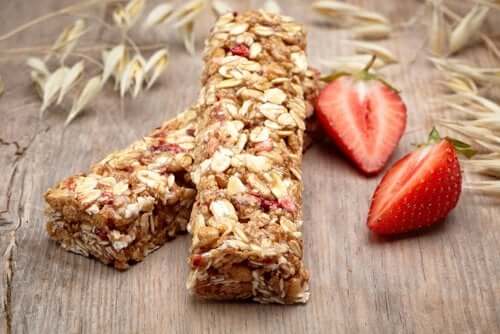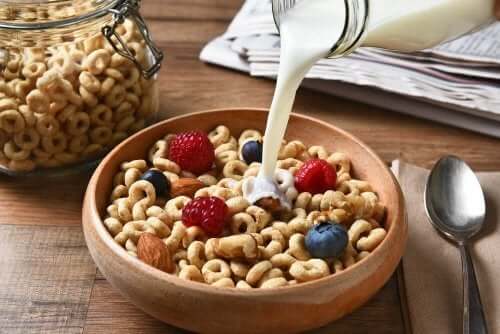What Are the Benefits of Grains in a Child's Diet?


Reviewed and approved by the doctor Nelton Ramos
Many parents wonder about the benefits of grains in their children’s diet. Another common question is just how much to include in their daily portions.
If this is your case, then today’s article will leave you more convinced than ever regarding grains. They offer a variety of benefits that contribute to the overall health of little ones.
What are grains?
Cereals are plants belonging to the grass family and get their name from Ceres, the goddess of Agriculture. These plants are cultivated for their grains, and are classified into two types. The main grains include wheat, corn, rice, oats and barley. Secondary grains include canary grass (bird seed) and millet.
Consuming grains has been an important part of the human diet for thousands or years, with the beginning of the settlements of the neolithic era. In fact, the cultivation and consumption of these plants allowed man to finally establish a fairly health diet. With this, they became less dependent on nomadic hunting.
Grains are such an important part of our diet as a modern civilization. In fact, an estimated six billion people consume these plants. Corn, rice, wheat and barley are those that are highest in cultivation and demand.
How are grains consumed?
Grains come in all sorts of presentations, and their uses may vary. Below, we’ll list the most common forms.
- Whole grains: Cereals that we eat in grain form are rice, corn, oats, barley, precooked wheat. Quinoa is also on this list, though it’s technically a pseudo cereal.
- As pasta: Grains can also come in the form of pasta. For example, wheat, corn, rye, rice and other grains can all come in pasta form. Thanks to its current popularity as a diet food, quinoa is also being used to make pasta.
- As flour: Wheat and rye are some of the most popular types of flour worldwide. They’re present in bread and a number of other bakery items. Corn is next on the list, especially on the American continent. Lastly, there is also flour that comes from rice and spelt, or hulled wheat.

What are the benefits of grains in a child’s diet?
Grains contain a variety of substances that are beneficial for the health of children. For example, they contain carbohydrates, proteins, lipids, fiber, minerals and group B vitamins.
Carbohydrates
Carbohydrates contribute to the development and proper growth of children. They offer energy without increasing cholesterol levels, and help in the functioning of the nervous system.
Proteins
Proteins boost the immune system, are beneficial for the heart, strengthen bones and offer basic nutrients for children’s growth.
Lipids
This is a group of nutrients that offer the energy that children need in order to carry out their daily activities.
“The principle grains include wheat, corn, rice, oats and barley. Secondary grains include canary grass (bird seed) and millet.”
Fiber
Fiber is one of the most important benefits of grains. It contributes to children’s proper intestinal functioning, thus reducing issues like constipation.
Furthermore, they’re foods that give children a sense of satisfaction. As a result, children will feel more full and less prone to reach for junk food and snacks between meals.
Mineral salts
Mineral salts favor the cognitive development of infants and are also beneficial to their growth.
Group B vitamins
Group B vitamins help to prevent problems having to do with memory and cognitive development. At the same time, they contribute to the growth of hair and nails and help keep muscles and skin healthy.
How much cereal should children eat
The most recommended grains during the first years of life are rice and oats. This is because they’re easy to digest and children love them.

Once children reach school age, then they should consume grains as part of their breakfast. Furthermore, they should also eat them as part of their lunch and dinner. The recommended amounts are at least 1.75 ounces per day in grains. These can be distributed in several smaller portions throughout the day.
As a final recommendation regarding the benefits of grains, remember to keep your child’s age into account, as well as any possible allergies and intolerances. Of course, you should also limit the amount of sugar and fat that the cereals you offer your child contain. The form in which your children get their grains will affect how beneficial they are for their health.
Many parents wonder about the benefits of grains in their children’s diet. Another common question is just how much to include in their daily portions.
If this is your case, then today’s article will leave you more convinced than ever regarding grains. They offer a variety of benefits that contribute to the overall health of little ones.
What are grains?
Cereals are plants belonging to the grass family and get their name from Ceres, the goddess of Agriculture. These plants are cultivated for their grains, and are classified into two types. The main grains include wheat, corn, rice, oats and barley. Secondary grains include canary grass (bird seed) and millet.
Consuming grains has been an important part of the human diet for thousands or years, with the beginning of the settlements of the neolithic era. In fact, the cultivation and consumption of these plants allowed man to finally establish a fairly health diet. With this, they became less dependent on nomadic hunting.
Grains are such an important part of our diet as a modern civilization. In fact, an estimated six billion people consume these plants. Corn, rice, wheat and barley are those that are highest in cultivation and demand.
How are grains consumed?
Grains come in all sorts of presentations, and their uses may vary. Below, we’ll list the most common forms.
- Whole grains: Cereals that we eat in grain form are rice, corn, oats, barley, precooked wheat. Quinoa is also on this list, though it’s technically a pseudo cereal.
- As pasta: Grains can also come in the form of pasta. For example, wheat, corn, rye, rice and other grains can all come in pasta form. Thanks to its current popularity as a diet food, quinoa is also being used to make pasta.
- As flour: Wheat and rye are some of the most popular types of flour worldwide. They’re present in bread and a number of other bakery items. Corn is next on the list, especially on the American continent. Lastly, there is also flour that comes from rice and spelt, or hulled wheat.

What are the benefits of grains in a child’s diet?
Grains contain a variety of substances that are beneficial for the health of children. For example, they contain carbohydrates, proteins, lipids, fiber, minerals and group B vitamins.
Carbohydrates
Carbohydrates contribute to the development and proper growth of children. They offer energy without increasing cholesterol levels, and help in the functioning of the nervous system.
Proteins
Proteins boost the immune system, are beneficial for the heart, strengthen bones and offer basic nutrients for children’s growth.
Lipids
This is a group of nutrients that offer the energy that children need in order to carry out their daily activities.
“The principle grains include wheat, corn, rice, oats and barley. Secondary grains include canary grass (bird seed) and millet.”
Fiber
Fiber is one of the most important benefits of grains. It contributes to children’s proper intestinal functioning, thus reducing issues like constipation.
Furthermore, they’re foods that give children a sense of satisfaction. As a result, children will feel more full and less prone to reach for junk food and snacks between meals.
Mineral salts
Mineral salts favor the cognitive development of infants and are also beneficial to their growth.
Group B vitamins
Group B vitamins help to prevent problems having to do with memory and cognitive development. At the same time, they contribute to the growth of hair and nails and help keep muscles and skin healthy.
How much cereal should children eat
The most recommended grains during the first years of life are rice and oats. This is because they’re easy to digest and children love them.

Once children reach school age, then they should consume grains as part of their breakfast. Furthermore, they should also eat them as part of their lunch and dinner. The recommended amounts are at least 1.75 ounces per day in grains. These can be distributed in several smaller portions throughout the day.
As a final recommendation regarding the benefits of grains, remember to keep your child’s age into account, as well as any possible allergies and intolerances. Of course, you should also limit the amount of sugar and fat that the cereals you offer your child contain. The form in which your children get their grains will affect how beneficial they are for their health.
This text is provided for informational purposes only and does not replace consultation with a professional. If in doubt, consult your specialist.








